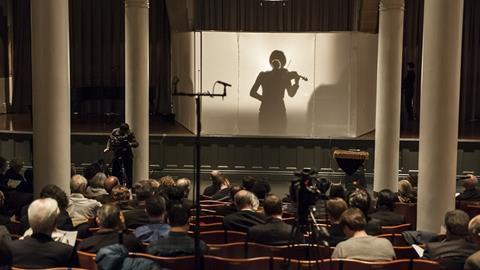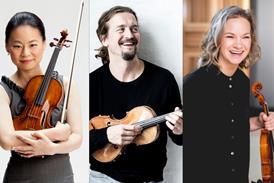Five years after the 2012 blind test of old Italian and new violins in Paris and New York, fresh analysis has found that new instruments project more effectively

Five years on from the largest ever blind test of old Italian and new violins, fresh analysis concerning sound projection has been published by the project's researchers.
The findings indicate that on average new violins project more effectively than those by Stradivari, and that both players and audiences are more likely to prefer instruments with better sound projection. While a 2014 paper published about the experiment concluded that soloists were unable to distinguish between old and new violins at better than chance levels, this new paper shows that audiences are no better than players at identifying new from old.
French acoustics specialist Claudia Fritz and US violin maker Joseph Curtin headed the 2012 experiment at the Auditorium Coeur de Ville in Paris and at the Great Hall of Cooper Union in New York along with strings expert Fan-Chia Tao. Their latest findings have been published on the Proceedings of the National Academy of Sciences (PNAS) website. The Strad's forthcoming June 2017 issue (published 19 May 2017) also features an article by Curtin on this research.
Central to the new results is the observation that 'the old violins were on average less loud under the ear...while the new were significantly louder’. In the concert hall, too, new instruments 'easily out-projected' most Stradivari violins, both with and without orchestra, while the most popular Strad 'scarcely out-projected' the least preferred new instrument. This contradicts the oft-quoted belief that old Italian instruments project more effectively while being softer under the ear.
Significantly, the best projecting new instrument was most preferred by the 50-strong audience and participating players alike, while the best projecting Strad was also the most popular of the old instruments. The four soloists who chose a Strad as their favourite chose a violin with significantly less projection than the two best-projecting new instruments.
The soloists taking part in the study were: Yi-Jia Susanne Hou (Canada), Ilya Kaler (pictured, Russia), Elmar Oliveira (US), Tatsuki Narita (France), Solenne Païdassi (France), Marie-Annick Nicolas (France) and Giora Schmidt (US).
The PNAS report concludes: 'The results are unambiguous: listeners found that new violins projected better than those by Stradivari....Moreover, listeners generally preferred the new instruments. Though the listeners came from various professional backgrounds (and included musicians, violin-makers, and acousticians), very similar results were obtained from all backgrounds. We find a strong correlation between projection with and without orchestra. This seems fortunate for both players and researchers in that an orchestra is evidently not required to meaningfully test projection.'
This is the second paper to have been based on the 2012 Paris blind test, the first having been published in 2014. A follow-up to the controversial experiment conducted in Indianapolis in 2010, the Paris experiment brought together ten 'renowned soloists' to compare the tonal qualities of twelve instruments – six by contemporary makers and six by 18th-century Italian luthiers (including five Strads) - both in a rehearsal room and on the concert stage.
As the players were told to judge each violin as if they were looking for an instrument that could best replace their own for an upcoming concert tour. Each player wore modified welders’ goggles and performed under very low ambient lighting, to ensure they could not identify the violins by sight. The soloists used their own bows throughout the study, and were allowed to compare test violins with their own instruments whenever they wished.
In one test the participants were asked to reject instruments they didn’t like and rank their four favourites in order, with the researchers awarding four points to each player’s top instrument. Rejected instruments had a point deducted from their overall score. In the second test all the violins were tested again in the concert hall. At the end of the test the players were given a series of violins and 30 seconds to guess whether it was old or new. In total, 33 of the soloists’ guesses were wrong and 31 right, with 5 indeterminate.
The final results showed that one modern instrument garnered a total of 26 points, being the top choice for four players, second choice for another four, and rejected by two. Conversely, a Stradivari ended up with a score of -9. Its closest rival was a modern instrument, which had a score of -7.
The results revealed the two most-preferred instruments to be modern, while in third place was a violin from Stradivari’s ‘golden period’. At the opposite end of the scale a Stradivari drew the poorest result and a modern instrument was placed second-last.
Photo: Hubert Raguet/CNS Phototheque
































No comments yet